Dioon Spinulosum Cycad
Dioon spinulosum cycad, commonly known as the Giant Dioon or Mexican Cycad, is a striking and ancient plant species belonging to the Zamiaceae family. Native to Mexico and parts of Central America, this slow-growing cycad is prized for its architectural form and long lifespan. It has a palm-like appearance, though it is not a true palm, and is often used as a focal point in landscapes or as a container plant indoors.
Key Characteristics:
- Scientific Name: Dioon spinulosum
- Common Names: Giant Dioon, Mexican Cycad
- Family: Zamiaceae
- Type: Evergreen, cycad
Appearance of Dioon Spinulosum Cycad:
- Leaves:
- Dioon spinulosum has long, graceful, arching fronds that can reach lengths of 5 to 7 feet. The leaves are dark green and pinnate (feather-like), with individual leaflets that are narrow and sharp-tipped, giving the plant a somewhat spiny or spinulose appearance. The leaflets grow in a symmetrical, radiating pattern along the central stem.
- Trunk:
- The plant develops a thick, sturdy trunk that can reach up to 10-15 feet tall in cultivation, though in the wild it may grow much larger, even up to 50 feet over many decades. The trunk is covered in a pattern of old leaf scars.
- Size:
- When grown outdoors in suitable conditions, Dioon spinulosum can become quite large, often reaching heights of 10 to 15 feet over time, with a spread of 6 to 8 feet. However, as a slow grower, it remains manageable in indoor or container settings.
- Flowers:
- Being a cycad, Dioon spinulosum produces cones rather than flowers. The male and female cones are produced on separate plants (dioecious). The cones are large and cylindrical, with the female cones being much larger than the male cones.
Growing Conditions for Dioon Spinulosum Cycad:
- Light:
- Dioon spinulosum prefers bright, indirect light when grown indoors, or partial shade to full sun outdoors. Too much direct sunlight in harsh conditions can scorch the leaves, so some protection is beneficial, especially during hot afternoons.
- Soil:
- Well-draining soil is essential to prevent root rot. A mix designed for palms or cacti, which combines potting soil with sand or perlite, works well. The soil should retain some moisture but not stay soggy.
- Watering:
- Water regularly during the growing season (spring and summer), allowing the top inch of soil to dry out between waterings. In the winter, reduce watering as the plant\’s growth slows. It’s important not to overwater, as cycads are susceptible to root rot.
- Humidity:
- Dioon spinulosum thrives in moderate humidity, typical of tropical environments. Indoors, it can tolerate lower humidity levels, but it benefits from occasional misting if the air is very dry.
- Temperature:
- This cycad prefers warm conditions, with an ideal temperature range of 65-85°F (18-29°C). It can tolerate brief periods of cooler temperatures but should be protected from frost and cold drafts.
Care and Maintenance of Dioon Spinulosum Cycad:
- Fertilization:
- Fertilize during the growing season with a balanced, slow-release fertilizer, or a specific palm or cycad fertilizer. Fertilize once a month in the spring and summer. Fertilization is unnecessary in the fall and winter.
- Pruning:
- Prune away any dead or damaged fronds at the base to keep the plant looking tidy. Be careful when handling, as the leaflets can be sharp.
- Repotting:
- Dioon spinulosum is a slow grower and doesn’t require frequent repotting. Repot every 3-5 years, or when the plant has outgrown its container. Choose a pot with good drainage to prevent waterlogged soil.
Common Problems:
- Overwatering:
- Overwatering can lead to root rot, one of the most common issues with cycads. Make sure to allow the soil to dry between waterings and ensure proper drainage.
- Pests:
- While generally pest-resistant, Dioon spinulosum may occasionally be affected by mealybugs, scale, or spider mites. Regular inspection and prompt treatment with neem oil or insecticidal soap can help control infestations.
- Leaf Yellowing:
- Yellowing of leaves may indicate nutrient deficiencies or improper watering. Ensure the plant receives enough light, and adjust watering and fertilization practices as needed.









Ashish Bhaskar –
Worth the price. Huge Plant received in good health
Shobhana Yadav (verified owner) –
Good size for price
Shobhana Yadav (verified owner) –
Nice